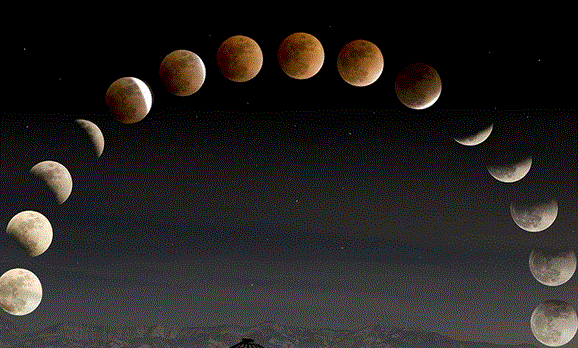As we will discuss later, there will be considerable cloudiness during the period, but I suspect several of you will be to view parts of the eclipse.
An interesting aspect of total lunar eclipses is that the moon is never completely blacked out, even though shadowed by the earth (see picture from an earlier eclipse below). Frequently, the moon takes on an orange or reddish color during totality.
But why does the moon not go completely dark? The reason: the earth's atmosphere!
Some of the sun's light is refracted or bent by the earth's atmosphere towards the darkened moon (see figure).
But why is the moon often reddish during a total lunar eclipse? The atmosphere tends to preferentially scatter and remove the shorter wavelengths of light, like blue and green, leaving longer wavelengths like red. That is why sunsets are red.
Some eclipses are redder than others. If the there is a substantial volcanic eruption that injects large amounts of particles into the atmosphere, more of the shorter wavelengths are removed resulting in a darker, redder moon during the eclipse.
So will you see it? Let's take a look at the latest WRF model forecast for 12 AM Tuesday morning. This figure shows the predicted cloudiness, which unfortunately is considerable, with the suggestion of a convergence zone over central Puget Sound. But there are some gaps over the northern coast of western Washington and some thin clouds over eastern Washington. Open around Vancouver and in portions of the Willamette Valley.
Looking at the 9 AM visible satellite image, one can see that the weak front approaching the Northwest is not very impressive...and quite broken up. This bodes well for some of you seeing at least portions of the eclipse. So don't give up!
Now if you miss this eclipse because of clouds, don't worry, this is the first total lunar eclipse in a series of four, also known as a "tetrad", with follow-on eclipses on October 8, 2014, April 4, 2015, and Sept 28, 2015.
Announcement
There’s an interested lecture series
starting this week:
Our Global Ocean: The Ultimate Planetary Life
Support System--New Approaches to an Old Ocean. A much better title would be 20,000 Gigabytes Under the Sea. The speaker, UW professor of oceanography
John Delaney, is leading the team of scientists and engineers at the UW who are
building the world’s largest underwater cabled observatory off the coast of
Oregon
to better understand the
complex ocean system that modulates climate. Lectures will be at 7 pm in Kane
Hall on April 15 and 29, May 6 and 20. This event is co-presented by the UW
Alumni Association and by Seattle Arts and Lectures. Register and buy tickets
through the SAL website here









Thank you for this explanation! I really like this. I do hope the clouds don't come in until after the eclipse.
ReplyDeleteIts the eclipse weather on August 21, 2017 down in Oregon that I am most concerned about. I plan to be just north of Elm Lane on Hwy 97 just north of Madras on that day. It will be right on the path of totality - for the solar eclipse!!!!!
ReplyDeleteHad to forward your rainbow blog to my son's 6th grade science teacher. Hope she doesn't take offense to my suggesting an addition to her curriculum today!
ReplyDeleteThank you and I am more informed because of your blog.